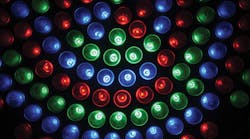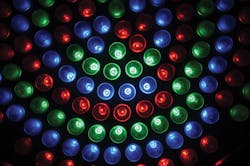Solid-state lighting (SSL) is shaping up to be a remarkably complex technology, combining the sciences of light and color with the potential to provide many features that were previously unattainable in a lighting system. The ever-growing lineup of SSL luminaires — today, these comprise light emitting diodes (LEDs) — delivers a combination of high electrical-to-photometric energy conversion (efficacy), optical efficiency, and ease of control that exceeds anything a fluorescent or HID light source can offer. Digitally addressable, an LED luminaire can network with control devices and other fixtures to enable centralized control and information feedback for maximum energy savings.
The LED source is essentially a semiconductor “chip,” very similar to computers and communications equipment in terms of its makeup. As such, it allows other components or elements, such as a microcontroller or a network communications interface integrated circuit, to be added to a luminaire’s driver module, moving lighting from a simple, switch ON/OFF technology to a more complex technology with the ability to provide cost and health benefits.
Before we discuss the potential health advantages of this technology, let’s review the ambient light sensing, communications capability, and performance/space monitoring benefits of today’s LEDs.
Ambient light sensing
An ambient light sensor (ALS) detects the amount of light in the proximity of the sensor, allowing the general illumination of a space to be lowered when another source of light (daylight) is present with very little additional cost to the LED lighting system. The ambient light sensor has improved over time to the point that, today, a sensor uses less than 1µA of current, has a range from 0.1 lux to 100,000 lux to cover most applications, and provides IR and UV blocking to remove any unwanted light in the non-visible spectrum from the actual system readings. In addition, a sensor that detects the color of the ambient light permits color tuning of RGB-type LED lighting systems.
To maintain the design target amount of light output over the lifetime of an LED fixture — say 60,000 hr for an indoor parking garage luminaire — a design may initially provide 30% more light than required, allowing the illuminated area to be overlit for much of the fixture’s lifetime. A SSL lighting design using an ambient light sensor and a dimming system can regulate light output in response to lumen depreciation (i.e., the loss of light over time). L70 is a parameter that describes the point in time at which the light output has decreased 30% from its initial value, and is typically on the order of 35,000 hr to 100,000 hr for LED lamps. Other benefits may include consistency of light intensity and color, and lower total thermal load.
Communications capability
As energy use codes have become more stringent, a communications system or network that allows lighting fixtures to connect with each other, with sensors and other data collection points, and with local and centralized control equipment is imperative. Proving more versatile than a simple occupancy sensor, a lighting control network offers increased energy savings by adapting the lighting system to changing conditions and allowing remote monitoring of electric consumption.
Networks are based on the seven-layer model developed by the International Organization for Standardization (ISO) model. The physical layer (Layer 1 of the model) describes the wired or wireless connection and how the data is modulated on a specific media. A full network stack for lighting doesn’t exist at present because one or more layers of the seven layers in the Open Systems Interconnection (OSI) model is often missing, and, in most cases, the application level (the top layer [Layer 7]) is absent.
Because it is essentially a low-voltage source, an LED fixture can be powered from a central location with low-voltage cabling, and controls can be run on the same category-type cable. Cabling professionals often recommend the use of Cat. 6 cabling for this application, because the conductors are comparatively large, thus lowering the DC resistance loss. Presently, the market is wide open on exactly how to combine these two services on a single cable, but a standards-based wiring system and network standard eventually should determine a winner.
Powerline communication (PLC), which uses existing electrical power conductor lines as the delivery media, is gaining acceptance because of new technology. Sending data over the existing AC power lines is an old concept chronically plagued by noise and high attenuation problems. However, new orthogonal frequency division multiplexing (OFDM) technology makes PLC networks reliable over longer distances. This new PLC standard, called G3-PLC communication, handles speeds up to 300 kbps, offers mesh networking capability, and features a robust mode for high noise conditions.
Many municipalities and other agencies are installing controllable outdoor LED lighting (COL) networks for street and highway illumination using the newest powerline communications techniques. Because LED streetlights can be continuously dimmed while retaining their efficacy — or turned on and off repeatedly without any reduction in their useful life — roadway lighting levels also can be adjusted to suit weather/atmospheric conditions, making outdoor LED luminaires one of the best markets for potential energy savings.
A new lighting industry group, called the TALQ Consortium, is working to create a software protocol specification for the applications layer in the OSI network model that would link a central management system and an outdoor lighting system power network’s communications system. Independent of the various typologies used today (e.g., wireless, power line, etc.), this standard allows for future standards developments. More information is available at www.TALQ-consortium.org.
One interesting example of integrated LED control for an indoor space is a recessed fixture, which allows each luminaire to dim down to 5% using 0VDC to 10VDC control; a fully operational lighting control system can be constructed by simply connecting the luminaires with category-type cabling. Furthermore, the controller under-drives the fixture to deliver constant light output over the product’s rated life, in addition to saving energy. Each luminaire tracks its own operating hours and provides a visual indicator that it has reached the end of its service life. Other manufacturers are providing each luminaire, or light source, with its own IP address and wireless communication ability, thus offering a number of ways to control the lighting and manage energy use.
Performance/space monitoring
Clearly, the industry is moving toward what could be called an “intelligent” lighting control system that uses sensors, programmatic controls, and communications links to detect what is happening within a lighting system in a building. The essential elements of an intelligent lighting system includes dimmable luminaires, sensing options, a robust lighting network that allows fixtures to communicate with each other, and centralized control and software.
An example of performance/space monitoring capabilities can be seen by considering a typical office area. Installing a single, small disk module in the ceiling located adjacent or within a luminaire can, in addition to detecting the light level, register other conditions, such as occupancy, temperature, carbon dioxide level, carbon monoxide level, air pressure, air velocity, humidity, particulate, and color. With such a system, not only is energy use recorded and stored, but the occupancy or use of a conference room or other office space can also be monitored on a real-time basis.
Finally, fuzzy logic technology will enable these systems to become more efficient by enabling active learning — prediction of occupancy and even a user’s desired light level.
Health considerations
LEDs are also showing general health benefits for humans. An LED is made like other semiconductor products, with each diode being cut from a wafer of crystals layered over a base of silicon, sapphire, nitride, or some other material. The crystal layer on early LEDs was gallium arsenide or gallium phosphide, which produces a narrow band of red color. All other colors, such as green, blue, or amber, also depend on the semiconductor materials used to make the diode.
Because LEDs emit light at precise wavelengths — that is, where a specific spectral composition of light is important — they are ripe for medical/health benefit applications. We are just at the threshold of understanding how light levels and colors affect people — the intricacies of the interaction between lighting and our circadian rhythms.
When we don’t receive a strong, regular reception of light (similar to daylight), our “body clock” malfunctions. If a lighting control system can adjust the spectral content of light as well as the light level throughout the day, imitating the daylong presence of sunlight, it can help our biological clock, or circadian rhythm, stay in sync. During the central part of the day, blue light, at about 460 nm, stimulates hormone production for alertness and activity. Later in the day and evening, warmer color temperatures are preferred to help in the production of melatonin, the hormone secreted from the pineal gland that is needed for sleep activity.
A majority of older adults report experiencing problems with sleep, and the LED light source can assist in providing the optimum amount of light and preferential wavelengths for people throughout the day. A 2008 study, with subjects whose average age was 85.5, demonstrated improvements in depression, agitation, and sleep when they received high daytime levels of light — plus or minus 92 fc. The ANSI/IES RP-28-07 document, “Lighting and the Visual Environment for Senior Living,” has recommendations for the aging population. However, they only apply for vision.
In 1980, The National Institute of Mental Health (NIMH) discovered the connection between light and health in an experiment that demonstrated how bright white light could suppress melatonin production. A few years later, scientists demonstrated that circadian rhythms in humans could be disrupted. In 2001, Dr. George C. Brainard, a professor of neurology in the Jefferson Medical College at Thomas Jefferson University, found that circadian rhythms could be disrupted with fairly low levels of blue light. He and other researchers concluded that the eye must have photoreceptors sensitive to blue light that perform non-visual functions. This hypothesis was confirmed a year later, when researchers at two institutions physically isolated the receptor.
Counting on the versatility of SSL, one LED maker thinks that “biological-specific lights,” tuned so as not to interfere with an individual’s normal production of melatonin, could reach the lighting market in about two years.
Another example of what the future holds is a small home lighting system that provides visual entertainment features. The system, which is controllable through a smartphone or tablet, consists of three LED Edison-based lamps and a bridge that plugs into a Wi-Fi router using the ZigBee Light Link standard. Each A19-sized lamp contains red, green, blue, and white LEDs to create any color or different hues of white light, from warm candlelight to a cool blue sky color. For information on how LEDs create white light, see SIDEBAR: How LEDs Product White Light.
An app for this system features four preprogrammed lighting settings based on research concerning the biological effects that lighting has on the body. The manufacturer is also inviting developers to add even more features to this lighting system. This product appears to be close to what could be called “biological-specific lighting,” designed to not interfere with an individual’s normal production of melatonin.
From both a “green” and health benefit perspective, the transformative potential of LEDs lies as much in their controllability as in their inherent efficiency. This opens the door for lighting designers and specifiers to make the most of this new technology.
SIDEBAR: How LEDs Produce White Light
The first technique used in the 1990s to create a pleasant white color was to combine the light output of red, green, and blue LEDs, recognizing that LED light sources are inherently additive. However, each color of the electromagnetic spectrum produced by an LED chip has its own operating requirements and the driver — the bulbs’ controlling circuit board — is relatively complex.
Therefore, the most widely used method of additive mixing to achieve a white light is called a phosphor-converted blue (PCB) type, since the chip, or die, emits a blue color and the protecting lens covering the die has an interior coating of yellow phosphor, absorbing some of the blue light, converting that energy to yellow light. In combination, the resulting mix of color, which is a continuous energy spectrum with one or two peaks, is perceived as “white” light.
A third method, called remote-phosphor technology (RPT), is also slowly gaining acceptance in applications that require uniform illumination, color consistency, and high efficiency, such as downlights, high bay fixtures, and other applications. This method consists of an LED board containing royal blue LEDs, a mixing chamber, and a remote phosphor element. Available in a variety of optics, RTP offers glare reduction, higher system efficiencies, and high optical efficiency for the luminaire.
While phosphor-converted white LEDs are used in many general illumination applications, monochromatic/colored LEDs are also used in a number of applications such as the architectural and entertainment segments of the market.




